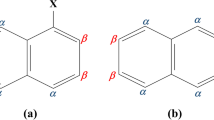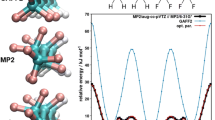Abstract
Several of the readily available theoretical programs are evaluated as tools for modeling the structures of polycyclic aromatic hydrocarbons with five-membered rings (CPAHs). The experimentally determined bond lengths and angles are compared to calculated values. Experimental bond lengths are also compared to Pauling and Huckel molecular orbital (HMO) bond orders. Previously published experimental X-ray and neutron-diffraction structures of acenaphthene, acenaphthylene, fluoranthene, cyclopent[o,p,q,r]benz[c]phenanthrene, and corannulene are modeled by the programs MMX, AM1, MNDO, and PM3, and previously reported STO-3G and 6-31G * data are also evaluated. In general, the error differences between the experimental and calculated results for all of the semiempirical programs were small. However, PM3 performed slightly better than AM1 and MMX, while MNDO generated structures which exhibited the largest deviation from experiment. Although the standard deviations for all programs are shown to be of comparable magnitude, a particular bond length or bond angle in any given theoretical calculation can exhibit significant error from the experimental data. The scatter in the bond order data computed from Huckel molecular orbital theory and valence bond theory is contrary to results obtained with alternant systems. It appears that these approaches are less successful at modeling accurately the nonalternant hydrocarbon systems described in this paper.
Similar content being viewed by others
References
Plummer, B. F.; Hall, R. A.J. Chem. Soc., Chem. Commun. 1970, 44–46.
Plummer, B. F.; Ferree, W. I.J. J. Chem. Soc., Chem. Commun. 1972, 306–307.
Plummer, B. F.; Hopkinson, M. J.; Zoeller, J. H.J. Am. Chem. Soc. 1979,101, 6779–6781.
Plummer, B. F.; Al-Saigh, Z. Y.J. Phys. Chem. 1983,87, 1579–1582.
Plummer, B. F.; Al-Saigh, Z. Y.; Arfan, M.J. Org. Chem. 1984,49, 2069–2071.
Plummer, B. F.; Al-Saigh, Z. Y.; Arfan, M.Chem. Phys. Lett. 1984,104, 389–392.
Plummer, B. F.J. Phys. Chem. 1987,91, 5035–5037.
Plummer, B. F.; Singleton, S. F.J. Phys. Chem. 1990,94, 7363–7366.
Plummer, B. F.; Russell, S. J.; Reese, W. G.; Watson, W. H.; Krawiec, M.J. Org. Chem. 1991,56, 3219–3223.
Plummer, B. F.; Reese, W. G.; Watson, W. H.; Kashyep, R. P.Struct. Chem. 1993,4, 53–57.
Samanta, A.; Fessenden, R. F.J. Phys. Chem. 1989,93, 5823–5827.
Samanta, A.; Devadoss, C; Fessenden, R. W.J. Phys. Chem. 1990,94, 7106–7110.
Samanta, A.J. Am. Chem. Soc. 1991,113, 7427–7429.
Harvey, R. G.; Geacintov, N. E.Acc. Chem. Res. 1988,21, 66–73.
Harvey, R. G.; Pataki, J.; Cortez, C; Di Raddo, P.; Yang, C. X.J. Org. Chem. 1991,56, 1210–1217.
Ehrlich, H. W. W.Acta Crystallogr. 1957,10, 699–705.
Hazell, A. C.; Hazell, R. G.; Norskov-Lauritsen, L.; Briant, C. E.; Jones, D. W.Acta Crystallogr., Sect. C,1986,42, 690–693.
Hazell, A. C.; Jones, D. W.; Sowden, J. M.Acta Crystallogr., Sect. B 1977,33, 1516–1522.
Ehrlich, H. W.; Beevers, C. A.Acta Crystallogr. 1956,9. 602–606.
Hanson, J. C.; Nordman, C. E.Acta Crystallogr., Sect. B 1976,32, 1147–1153.
Wood., R. A.; Welberry, T. R.; Rae, A. D. J.J. Chem. Soc., Perkin Trans. 2 1985, 451–456.
Gilbert, K. E., Serena Software: Bloomington, IN.
Dewar, M. J. S.; Thiel, W.J. Am. Chem. Soc. 1977,99, 4899–4907.
Dewar, M. J. S.; Zoebisch, E. G.; Healy, E. F.; Stewart. J. J. P.J. Am. Chem. Soc. 1985,107, 3902–3909.
Stewart, J. J. P.J. Comp.-Aided Mol. Design 1990,4, 1–104.
Stewart, J. J. P.;J. Comp. Chem. 1989,10, 209–220.
Peck, R. C.; Schulman, J. M.; Disch, R. L.J. Phys. Chem. 1990,94, 6637–6641.
Herndon, W. C.J. Am. Chem. Soc. 1974,96, 7605–7614.
Brock, C. P.; Dunitz, J. O.Acta Crystallogr., Sect. B 1982,38, 2218–2228.
Author information
Authors and Affiliations
Rights and permissions
About this article
Cite this article
Plummer, B.F., Steffen, L.K. & Herndon, W.C. Polycyclic aromatic hydrocarbons with five-membered rings: Modeling of experimental X-ray and neutron-diffraction structures. Struct Chem 4, 279–285 (1993). https://doi.org/10.1007/BF00673702
Received:
Revised:
Accepted:
Issue Date:
DOI: https://doi.org/10.1007/BF00673702




